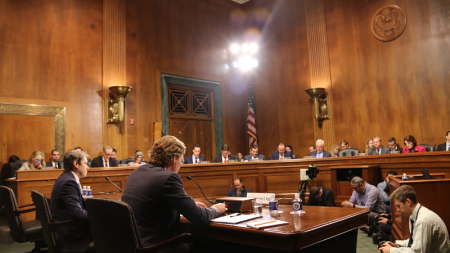The United States Defense Digital Service (DDS) will change leadership next month, with Director Brett Goldstein stepping down in June and deputy director Katie Olson stepping in as acting director, DDS confirmed to MeriTalk today. […]
Technology leaders in Congress and industry groups with a stake in Federal IT both applauded the Biden administration’s move today to relax Technology Modernization Fund (TMF) payback requirements in order to quickly put $1 billion of new funding to work to shore up agency cyber defenses and upgrade critical systems. The change in traditional TMF […]
The National Science Foundation (NSF) is kicking off a new initiative with Federal and private partnerships to accelerate research in areas that affect Next-Generation (NextG) networking and computing systems, NSF announced April 27. […]
The United States Coast Guard (CG) intends to work with one or more companies to help improve communications between Coast Guard Cutter tactical commanders and boarding teams, according to a notice of intent posted to the Federal registry April 27. […]
The United States Army Futures Command’s Command, Control, Computers, Communications, Cyber Intelligence, Surveillance, and Reconnaissance (C5ISR) has selected Booz Allen Hamilton to build a data fabric key to the Department of Defense’s (DoD) Joint All Domain Command and Control (JADC2) concept, the firm announced April 20. […]
The Nuclear Regulatory Commission (NRC) is looking into how it could use AI and machine learning in nuclear power generation and is seeking comment from the commercial nuclear power industry to help in that inquiry, according to an NRC request for comment published April 21. […]
More security incidents were detected by the intruded organizations last year, a positive trend in the cybersecurity sector as cyber threat actors are increasingly exploiting the remote work setup, a 2021 trends report by Fire Eye and Mandiant – both cybersecurity firms – found. […]
Top Federal technology leaders discussed the pressing need to address tech-sector workforce shortages at General Dynamics Information Technology’s Emerge 2021 digital modernization conference on April 6. GDIT President Amy Gilliland and Deputy Federal CIO Maria Roat both tackled the issue in keynote addresses and pointed to its importance in both the private and public sectors. […]
MeriTalk recently caught up with Ray McCay, vice president of solution sales, ViON Corporation, and Eric Trexler, vice president of global governments and critical infrastructure, Forcepoint, to discuss multi-cloud security risks, success factors, and how Federal IT teams can move from a reactive stance to a more proactive security posture in multi-cloud environments. […]
Government agencies and the private sector will spend $100 billion or more to recover from the SolarWinds hack, which went undetected for at least nine months and may have compromised 18,000 government and private sector organizations using SolarWinds Orion software. Even if breached organizations successfully mitigate the damage from SolarWinds, they know adversaries aren’t going to stop trying to get in. If they plug one vector of attack, the adversary will find another to exploit. […]
In response to a sharp spike in IT services and cybersecurity demands for a dispersed workforce, President Joe Biden made Federal technology modernization one of his early priorities, citing the need to upgrade Federal IT as “an urgent national security issue.” […]
During the nine months of the coronavirus pandemic, we’ve asked a hundred variations of that question to people whose professional lives near the tip of the technology spear put them in good positions to predict the future and get as many good answers back. At the dawn of a more hopeful 2021, here’s a look at how the Federal work-scape may play out in the longer term, courtesy of three veteran technologists. […]
The Department of Commerce Office of the Inspector General (OIG) announced last month that it will be conducting a review of the department’s cyber threat data sharing capabilities, pursuant to the Cybersecurity Information Sharing Act of 2015 which set up structures for sharing threat data with government and private sector entities. […]
The Department of Defense (DoD) Prototypes and Experiments office is looking for submissions ahead of a solutions meeting that the office expects to hold in late spring 2021, according to a Dec. 22 release. […]
The Alliance for Digital Innovation (ADI), a Washington-based trade group known for its advocacy for Federal government IT modernization, released a new set of recommendations Dec. 17 for the Biden administration and incoming Congress to improve Federal tech capabilities by learning from some of the lessons of the government’s rapid turn to telework during the coronavirus pandemic. […]
The shift to remote work forced by the coronavirus pandemic has helped the Army’s Combat Capabilities Development Command (CCDC) – a component of Army Futures Command – identify security gaps, and work to improve IT security for offsite personnel, said Col. Gregory Smith, Military Deputy to the Director of the CCDC, at an AFFIRM webinar Dec. 16. […]
Senior executives with Google Cloud emphasized at their first Public Sector Summit on Dec. 8 the work that the company has been doing with a variety of public sector organizations during the coronavirus pandemic, and one emerging silver lining to the health crisis: a big leap forward in IT modernization that will help government and academia during the recovery. […]
Three tech-sector veterans, in conjunction with MeriTalk, will cut through the confusion about an important aspect of the new tech environment – the virtual desktop experience – during a virtual tech briefing set for Wednesday, Oct. 14, from 1:30 pm to 2:30 pm Eastern time. The complementary briefing will explain how to make the virtual desktop experience productive, efficient, and safe. […]
Weeks after the Department of Defense announced additional mid-band spectrum would be available for industry use, the department is circling back to industry requesting more information on spectrum sharing. […]
A new study shows that the transition to 5G wireless services will create an additional 4.6 million jobs in the United States by 2034 – and that the move to the latest generation of wireless technology has created over 100,000 jobs already since last year. […]
Denver-based communications services provider CenturyLink said it is changing its name to Lumen Technologies. […]
Another piece of the Cybersecurity Maturity Model Certification puzzle has fallen into place with the Accreditation Body announcing 11 companies as Licensed Partner Publishers who will develop curricula for the Department of Defense’s new cybersecurity standard for its supply chain companies. […]
Nine more companies have joined the Open RAN Policy Coalition, bringing the total number of members to 54. The coalition, formed in May, is seeking to promote policies to open up the radio access networks– a key part of the architecture necessary for 5G wireless services. […]
With the White House and Department of Defense recently announcing that additional mid-band spectrum will be made available to be shared with industry, the Federal government’s spectrum manager called on the Federal Communications Commission (FCC) to do its part to ensure the partnership occurs smoothly. […]
The Information Technology Industry Council this week released its guide for cybersecurity certification, which includes a warning against a “one-size-fits-all solution” in certification. […]
Leaders on spectrum issues both on and off the Hill praised the Department of Defense’s announcement to make additional mid-band spectrum available for commercial use, lauding the decision’s potential effects for industry and government. […]
Amb. Robert Strayer, the Department of State’s point person for cyber and international communications policy, is leaving government to join the Information Technology Industry (ITI) Council, a global technology trade association. […]
The Virginia-based company Ligado announced it is joining the Open RAN Policy Coalition, a group created to promote policies of openness and interoperability in a key part of the architecture used by mobile devices particularly for 5G use. […]
Verizon has hired Jennifer Chronis to lead its Verizon Public Sector business beginning next month. […]
Google’s Chief Executive Officer Sundar Pichai told employees in an email that the company will extend its voluntary work-from-home option through June 2021. […]


























